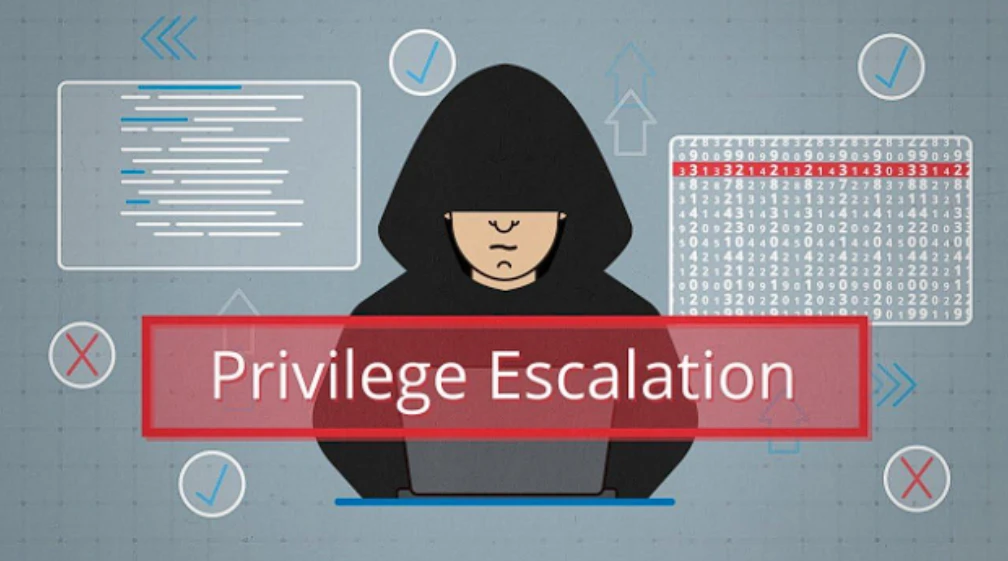What is Privilege Escalation in Cybersecurity?
Privilege escalation in cybersecurity refers to a tactic used by attackers to gain unauthorized access to elevated permissions within a system, application, or network. This occurs when a user or malicious actor exploits a flaw, misconfiguration, or vulnerability to move from a lower level of access to a higher one. Once elevated, the attacker can execute sensitive commands, access restricted data, install malware, disable security tools, or create new user accounts with administrative rights.
There are two main types of privilege escalation: vertical and horizontal. Vertical privilege escalation happens when an attacker elevates their privileges from a regular user to an administrator or root-level account. This type of escalation gives the attacker complete control over the system. For example, a hacker may exploit a vulnerability in an outdated operating system to give themselves administrative access, bypassing traditional security controls. On the other hand, horizontal privilege escalation involves a user gaining access to another user’s data or privileges without necessarily increasing their overall permission level. For instance, one user might be able to view or manipulate another user’s files due to a flaw in access control policies.
Privilege escalation is not typically the first stage of an attack. It usually follows an initial compromise—such as a successful phishing attempt, credential theft, or malware infection—after which the attacker begins probing the environment for ways to gain greater control. Once elevated privileges are obtained, attackers can move laterally across the network, persist in the environment for longer periods, and execute damaging actions undetected.
This tactic is especially dangerous because it allows attackers to blend in with legitimate users, making it harder for traditional security systems to detect malicious activity. In some cases, attackers will also use privilege escalation to disable logging or security tools, further masking their presence and increasing the likelihood of a prolonged breach.
To defend against privilege escalation, organizations must adopt a layered security approach. This includes applying the principle of least privilege (POLP),regularly updating and patching systems, conducting audits of user permissions, and monitoring for unusual behavior. Privilege escalation may be a complex subject, but it is a critical concept for any cybersecurity strategy. Knowing how it works and how to defend against it can make a significant difference in the speed and success of incident detection and response.
Types of Privilege Escalation Attacks
Privilege escalation attacks come in different forms, but they all share a common goal—gaining unauthorized access to higher levels of control within a system. Understanding the types of privilege escalation attacks is essential for identifying threats and preventing major security incidents. These attacks are generally classified into two categories: vertical and horizontal privilege escalation.
Vertical privilege escalation occurs when a user gains access to permissions beyond their current level. This is the most well-known form of escalation and often the most damaging. An attacker may begin with access to a standard user account but manage to exploit a system flaw to obtain administrative privileges. With this new level of control, the attacker can alter system settings, disable security software, steal sensitive data, and even create backdoors for future access. Common tactics for vertical escalation include exploiting unpatched software, misconfigured file permissions, and abusing operating system vulnerabilities.
Horizontal privilege escalation, while less talked about, is also a serious concern. This type of attack allows a user to gain access to resources or data belonging to another user with the same privilege level. For example, in a web application, an attacker may modify a request parameter to access another user’s profile, orders, or documents. Although the attacker hasn’t elevated their role, they have bypassed access controls and compromised data integrity and confidentiality.
Within these two main categories, there are various techniques used to execute privilege escalation. Attackers might use password dumping tools to retrieve stored credentials, exploit kernel-level bugs, take advantage of insecure services, or leverage scheduled tasks and service misconfigurations. Malware often plays a role as well, embedding itself in the system and waiting for an opportunity to escalate privileges silently.
Another common method involves DLL hijacking, where a malicious dynamic-link library file is loaded by a trusted application. Similarly, attackers may inject malicious code into processes that are already running with high-level privileges, allowing them to perform tasks as if they were the system administrator.
Understanding the different types of privilege escalation attacks is the first step in designing effective defenses. By identifying the methods that attackers use to move up the access ladder, security teams can implement safeguards that limit damage, increase detection speed, and reduce the window of opportunity for unauthorized actions. Privilege escalation may take many forms, but with proper awareness and defense strategies in place, its impact can be minimized significantly.
Common Techniques Used in Privilege Escalation
Privilege escalation attacks rely on a variety of techniques to move from limited access to elevated control. These techniques often take advantage of system vulnerabilities, misconfigurations, or weak security policies. While the specific approach may vary depending on the attacker’s environment and objective, the underlying goal remains the same—bypass restrictions and gain unauthorized control.
One of the most common techniques is exploiting software vulnerabilities. Many applications and operating systems contain flaws that can be leveraged to execute code with elevated privileges. These vulnerabilities, especially those related to local privilege escalation (LPE),are often targeted through known exploits that can be automated. Attackers frequently rely on outdated or unpatched systems to succeed, which is why keeping systems updated is one of the most effective ways to mitigate this risk.
Misconfigured permissions are another frequent target. If files, directories, or processes are accessible or modifiable by users who shouldn’t have that level of access, attackers can use these flaws to insert malicious code, overwrite configuration files, or escalate their role. For instance, if a service is running with administrative privileges and reads from a user-writable directory, an attacker could replace legitimate files with malicious ones that get executed with elevated rights.
Credential dumping is a technique where attackers extract stored login credentials from memory or configuration files. Tools like Mimikatz are designed specifically for this purpose. Once attackers obtain administrative usernames and passwords, they can impersonate legitimate users and perform any action that the account is authorized to execute.
DLL injection and DLL hijacking are also widely used. In these cases, attackers trick applications into loading malicious DLL files instead of legitimate ones. Because many programs automatically load DLLs from specific directories, placing a rogue file in the right location can give an attacker the ability to run code under the privileges of that application.
Token manipulation and process injection are additional techniques used to execute code within the context of a higher-privileged process. Attackers may duplicate or steal access tokens from privileged processes and use them to impersonate authorized users. They may also inject malicious code into system processes to run commands with administrative rights.
In some cases, scheduled tasks and services are exploited. If attackers can modify or create tasks that run with elevated privileges, they can schedule their payloads to execute during system startup or regular intervals, maintaining persistent access.
Each of these techniques represents a potential path to privilege escalation. When combined with other tactics like social engineering or initial access via phishing, they can become powerful tools in the hands of an attacker. Understanding these methods is key to building defenses that detect, block, and respond to escalation attempts quickly and effectively.
Privilege Escalation vs Initial Access and Lateral Movement
Privilege escalation, initial access, and lateral movement are all distinct but interconnected phases of a cyberattack. Understanding how they differ—and how they fit into the broader context of an attack—is essential for building a strong cybersecurity defense strategy. Each stage represents a different objective, and attackers often chain them together to maximize their access, control, and impact within a network.
Initial access refers to the first point at which an attacker successfully gains entry into a system or environment. This could happen through phishing emails, credential stuffing, exploiting vulnerabilities in web applications, or using malware to bypass security controls. At this point, the attacker typically has very limited access—often equivalent to that of a standard user or an unprivileged service account. The goal during this stage is to establish a foothold while remaining undetected.
Privilege escalation comes next. After gaining initial access, the attacker attempts to increase their level of control by exploiting weaknesses in the system. This step is crucial because it allows the attacker to move beyond the limitations of a low-privilege account. By escalating privileges, the attacker can access sensitive data, disable security features, or create new user accounts with administrative rights. In many cases, successful privilege escalation turns a small breach into a full-blown security incident.
Lateral movement is what happens after the attacker has escalated their privileges. At this point, the focus shifts to moving across systems within the network. With elevated access, the attacker can scan for other machines, identify valuable targets, and use stolen credentials or exploits to jump from one system to another. The purpose of lateral movement is to expand control, harvest more data, or prepare for a larger operation like ransomware deployment or data exfiltration.
While these stages are often executed in sequence, they are not always linear. An attacker may perform privilege escalation more than once if they encounter different levels of access across multiple systems. Similarly, lateral movement can be both a goal and a method, as attackers search for systems where higher privileges can be gained.
By understanding how privilege escalation fits between initial access and lateral movement, security teams can design better defenses. Monitoring for unusual behavior during each of these phases helps detect threats early. Implementing strong identity controls, limiting unnecessary privileges, and using segmentation to isolate systems can prevent attackers from successfully moving through all three stages. Recognizing the difference between these tactics is the first step toward disrupting the attack chain before real damage is done.
How to Detect Privilege Escalation in Your Network
Detecting privilege escalation in a network is one of the most critical steps in stopping a cyberattack before it causes serious damage. Because privilege escalation often occurs after an attacker has already gained initial access, identifying it quickly can be the difference between a contained incident and a widespread breach. The challenge is that attackers often try to blend in with normal user activity, making detection difficult without the right tools and strategies.
One of the most effective ways to detect privilege escalation is through behavioral monitoring. When a user suddenly performs actions that are outside their normal activity patterns—like accessing administrative tools, modifying system configurations, or launching sensitive processes—it can signal an escalation attempt. Tools that track user and entity behavior analytics (UEBA) are specifically designed to flag these kinds of anomalies.
Another key method is log analysis. System logs, event logs, and security audit trails can reveal important clues about privilege escalation. For example, unexpected changes to access control lists (ACLs),new user account creations, or attempts to disable antivirus or endpoint protection software can all indicate suspicious activity. Security Information and Event Management (SIEM) platforms help centralize these logs and apply rules to identify potentially malicious actions.
Monitoring for process injection or unusual command-line usage is also important. If a standard user suddenly runs PowerShell scripts, makes registry changes, or starts processes typically associated with administrators, it could be a red flag. These commands are often used by attackers to modify system behavior, download additional tools, or maintain persistence.
Unusual login patterns can also help detect escalation attempts. For example, if a user logs in from an unfamiliar IP address and then quickly attempts to access high-privilege resources, it may suggest compromised credentials being used for escalation. Similarly, multiple failed attempts to run privileged commands followed by a successful execution may indicate trial-and-error escalation techniques.
Another detection strategy is setting up decoy accounts or files—also known as honeypots. These are designed to appear valuable or privileged but are never accessed in normal operations. If they are touched, it’s likely that an attacker is probing the system for escalation paths.
Effective detection isn’t just about having the right tools—it’s also about knowing what to look for. Regular audits, privilege reviews, and real-time alerts are essential for catching privilege escalation before it spirals into something more serious. With proper visibility and vigilance, organizations can reduce the window of opportunity for attackers and strengthen their overall security posture.
Why Privilege Escalation is a Key Step in Cyber Attacks
Privilege escalation plays a central role in the success of most cyberattacks. Once an attacker gains a foothold in a system—often through phishing, malware, or exploiting an external vulnerability—their next objective is typically to escalate privileges. Without elevated access, an attacker’s capabilities remain limited. They may be able to view basic files or run simple commands, but they won’t have the control needed to cause serious damage, move laterally, or achieve their final objective. This is why privilege escalation is often the turning point where a minor security issue becomes a major breach.
With higher-level access, attackers can disable security tools, erase logs, extract sensitive data, and install persistent malware. In many cases, privilege escalation enables them to impersonate legitimate administrators, which helps them avoid detection for longer periods. The more control they gain, the harder it becomes for defenders to respond effectively or even realize something is wrong. Attackers may also use escalated privileges to unlock access to other systems or services that are otherwise isolated or protected.
This step is especially important in targeted attacks, such as those conducted by advanced persistent threats (APTs),where the goal is long-term access to high-value systems. In ransomware operations, for instance, attackers often lie dormant after initial access until they’ve escalated their privileges enough to deploy encryption across an entire network at once. In other words, privilege escalation helps them go from being a small nuisance to having full control over a business’s most critical systems.
It also enables lateral movement, where attackers travel through a network to find more valuable assets. Without escalated privileges, they are often stuck within the confines of the initial machine they compromised. But with administrative rights, they can extract credentials, scan for vulnerabilities in connected systems, and open paths to more secure areas of the network. This makes privilege escalation a key link in the broader attack chain.
From a defense perspective, preventing or detecting privilege escalation early can dramatically limit the scope of a breach. Organizations that enforce the principle of least privilege, segment their networks, and monitor for signs of escalation can disrupt an attack before it reaches its most dangerous phase.
In essence, privilege escalation gives attackers the keys to the kingdom. It allows them to operate as insiders, carry out complex attack strategies, and maximize the impact of their intrusion. Recognizing its importance is critical for building a layered security strategy that keeps threats contained.






